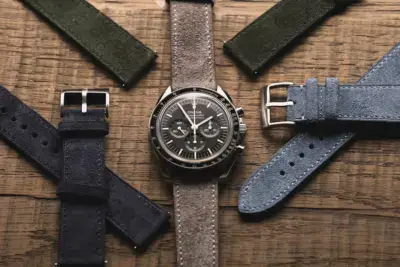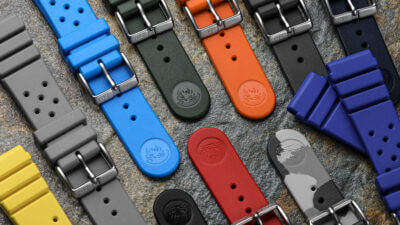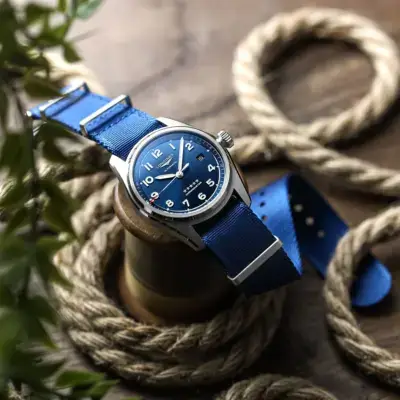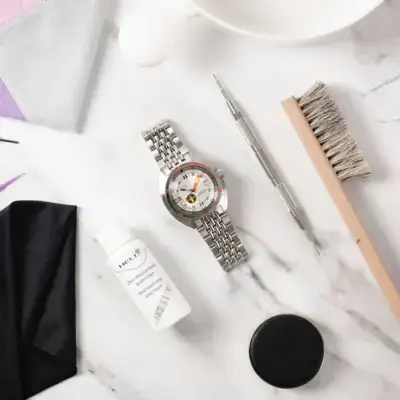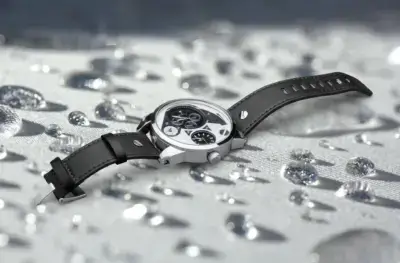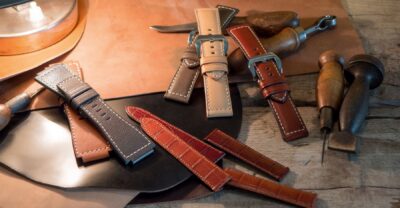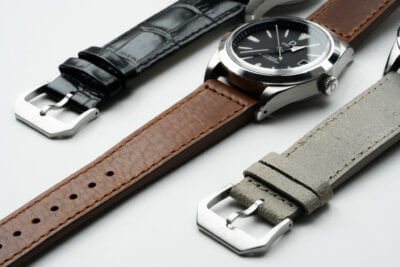Maintenance & Care
Frequently Asked Questions
How often should I clean my watch strap?
Cleaning your watch strap is essential for maintaining its appearance and longevity. The frequency of cleaning largely depends on the material of the strap and your lifestyle activities. Typically, leather watch straps should be cleaned every 2-3 months to preserve their quality. For metal, rubber, and nylon straps, a monthly cleaning routine is advisable, especially if you wear them during sports or in hot weather.
Leather watch straps require gentle handling. Use a damp cloth to wipe away any surface dirt, and avoid soaking the leather. For deeper cleaning, use a leather cleaner specifically designed for watch straps. After cleaning, let the strap air dry completely before wearing it again to prevent moisture damage.
Metal straps can be cleaned with a mixture of warm water and mild soap. Use a soft brush to gently scrub away any dirt or grime trapped between the links. Rinse thoroughly and dry with a soft cloth to prevent water spots. Similarly, rubber and nylon straps can be cleaned with soap and water, but make sure to dry them completely to avoid any mildew growth.
Regular cleaning not only extends the life of your watch strap but also enhances your wearing experience by keeping it fresh and comfortable. For more detailed guides on specific watch strap materials, visit our Watch Strap Guides (How-To & Educational) page.
What are the best practices for storing watch straps?
Proper storage of watch straps is crucial to maintaining their condition and longevity. Whether you own leather, metal, nylon, or rubber straps, storing them correctly can prevent damage and wear over time. Here are some best practices for storing your watch straps:
- Use a Watch Storage Case: Invest in a dedicated watch storage case or box that offers individual compartments for each strap. This prevents them from rubbing against each other and getting scratched or tangled.
- Avoid Direct Sunlight: Store your watch straps in a cool, dry place away from direct sunlight. Prolonged exposure to sunlight can cause fading and deterioration, especially in leather and rubber straps.
- Keep Away from Moisture: Moisture can damage most watch straps, particularly leather ones. Ensure your storage area is dry, and consider using silica gel packets to absorb any excess humidity.
- Store in a Flat Position: Avoid bending or twisting straps when storing them. Keeping them flat helps maintain their shape and prevents creases or cracks, especially in leather straps.
Following these storage practices can significantly enhance the lifespan and appearance of your watch straps. For more storage solutions, explore our Watch Storage collection.
How do I maintain the quality of my leather watch strap?
Leather watch straps exude elegance and sophistication, but they require specific care to maintain their quality over time. Here are some tips to ensure your leather strap remains in top condition:
1. Regular Cleaning: Clean your leather strap regularly with a damp cloth to remove any surface dirt. For deeper cleaning, use a leather cleaner designed for watch straps. Avoid using harsh chemicals that can damage the leather.
2. Condition the Leather: Conditioning your leather strap every few months helps keep it supple and prevents it from drying out and cracking. Use a high-quality leather conditioner and apply it sparingly with a soft cloth.
3. Avoid Water and Moisture: Leather is sensitive to water and moisture, which can cause it to warp or stain. Remove your watch before swimming, showering, or engaging in activities that may expose it to water.
4. Protect from Direct Sunlight: Prolonged exposure to sunlight can fade and weaken leather. Store your watch in a cool, shaded place when not in use to preserve its color and texture.
By following these maintenance tips, you can ensure that your leather watch strap remains a timeless accessory. For more information on leather watch straps, check out our Leather collection.
What should I do if my metal watch strap gets scratched?
Scratches on metal watch straps are common, especially with regular use. Fortunately, there are ways to minimize their appearance and restore the strap's shine. Here's what you can do if your metal watch strap gets scratched:
1. Use a Metal Polish: For light scratches, a metal polish can be effective. Apply a small amount of polish to a soft cloth and gently rub it onto the scratched area in a circular motion. Wipe off any excess polish with a clean cloth.
2. Buff with a Polishing Cloth: A polishing cloth can help buff out minor scratches and restore shine. Use gentle, consistent strokes along the grain of the metal to avoid creating new scratches.
3. Professional Refinishing: For deeper scratches, professional refinishing may be necessary. A jeweler or watch repair specialist can use specialized tools to remove scratches and restore the strap to its original condition.
4. Prevent Future Scratches: To minimize future scratches, avoid wearing your watch during activities that may expose it to rough surfaces or impacts. Regularly clean your strap to remove any dirt or debris that could cause abrasion.
For more tips on maintaining your watch straps, visit our Watch Strap Maintenance & Care page.
Can I replace my watch strap myself, and how do I do it?
Yes, you can replace your watch strap yourself with the right tools and a bit of patience. Here's a step-by-step guide to help you do it:
1. Gather Your Tools: You'll need a spring bar tool, which is specifically designed for removing and installing watch straps. You can find these tools in our Watch Tools collection.
2. Remove the Old Strap: Place your watch face down on a soft surface to prevent scratches. Use the forked end of the spring bar tool to compress the spring bar by inserting it between the strap and the watch lug. Gently push the spring bar out of the lug hole, and remove the strap.
3. Install the New Strap: Insert one end of the spring bar into the lug hole of the watch case. Use the spring bar tool to compress the other end of the spring bar and align it with the opposite lug hole. Once aligned, release the spring bar to secure the strap in place.
4. Check the Fit: Ensure the new strap is securely attached by gently tugging on it. If it feels loose, repeat the installation process to ensure a snug fit.
Replacing your watch strap is a simple process that can be done at home with the right tools. For more information on watch strap sizes, explore our 20mm, 22mm, 24mm, and 18mm collections.
How do I care for my rubber watch strap?
Rubber watch straps are known for their durability and versatility, making them a popular choice for sports and outdoor activities. However, they require regular care to maintain their flexibility and appearance. Here's how you can care for your rubber watch strap:
1. Regular Cleaning: Clean your rubber strap with mild soap and water to remove dirt and sweat. Use a soft brush to scrub gently, especially if the strap has a textured surface. Rinse thoroughly and dry with a soft cloth.
2. Avoid Harsh Chemicals: Exposure to harsh chemicals can weaken rubber straps and cause discoloration. Avoid contact with solvents, oils, and perfumes, which can degrade the material.
3. Protect from Extreme Temperatures: Rubber can become brittle in extreme cold and soft in high heat. Store your watch in a temperature-controlled environment to prevent damage.
4. Inspect Regularly: Regularly check your rubber strap for signs of wear, such as cracks or splits. Replace the strap if you notice any damage to ensure the safety of your watch.
By following these care tips, you can extend the life of your rubber watch strap and keep it looking new. For more information on rubber watch straps, visit our Rubber collection.
Are there any specific tips for maintaining nylon watch straps?
Nylon watch straps are popular for their comfort and durability, especially among outdoor enthusiasts. They are relatively low-maintenance but still require some care to ensure they last. Here are specific tips for maintaining your nylon watch strap:
1. Regular Washing: Nylon straps can be machine washed in a gentle cycle or hand washed with mild soap and water. If machine washing, place the strap in a mesh laundry bag to prevent tangling. Air dry the strap completely before reattaching it to your watch.
2. Avoid Prolonged Sun Exposure: While nylon is resistant to fading, prolonged exposure to direct sunlight can still cause colors to fade over time. Store your watch in a shaded area when not in use.
3. Prevent Fraying: To prevent fraying, use a lighter to carefully seal the edges of the strap. This is particularly useful if you have cut the strap to a custom length.
4. Inspect for Wear: Regularly check your nylon strap for signs of wear, such as fraying or weakened areas. Replace the strap if you notice any significant damage to maintain the security of your watch.
For more insights into nylon watch straps and their maintenance, visit our Nylon collection.

